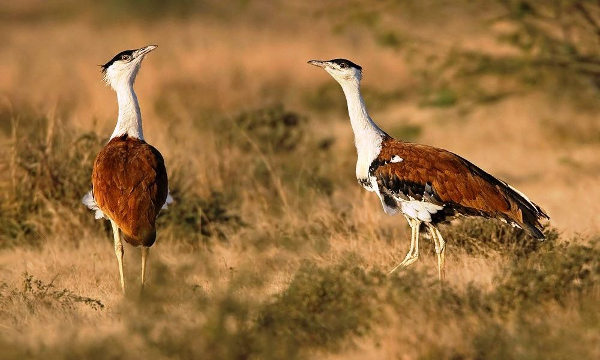Captive breeding is a new ray of hope for the conservation of the Great Indian Bustard (GIB), which is on the verge of extinction. At least 9 GIB have been artificially hatched in the Desert National Park (DNP) in Jaisalmer district. This is a big success for the joint team of state Forest Department and Wildlife Institute of India (WII).
Desert National Park deputy conservator of forest Kapil Chandrawal has confirmed the artificial hatching of 9 GIBs. The joint team had collected 10 GIB eggs from the DNP area. GIB, the state bird of Rajasthan, figures as critically endangered in the International Union for Conservation of Nature (IUCN) list, 2011, and Schedule-I that accords it the highest level of legal protection under the Wildlife (Protection) Act, 1972. Wildlife Institute of India (WII) surveys show that the number of GIB has reduced by 75% in the last 30 years. Currently, the GIB population in India is fewer than 150.
“The major reason behind the population of the bird not increasing is primarily because it is a very slow breeder. It lays just one egg in a year and that too in an open place in the dry grasslands. The egg(s) are mostly destroyed by predators such as fox, pigs, dogs, lizard, mongoose and cattle. Apart from this, due to recent developments in the area, like after the canal water reaching Jaisalmer, population of dogs, pigs, Nilgai, has risen which led to the drop in GIB population as well as setting up of the windmills and high voltage power lines in their habitat are another threats to GIB,” said Dr Hemsingh Gehlot, Assistant Professor in the Zoology at Jai Narayan Vyas University.
However, to ensure that the eggs of Great Indian Bustard are not destroyed by predators in their enclosures, the Ministry of Environment, Forests and Climate Change has recently allowed “management” of the predators in Desert National Park.
Source: HT
Image Courtesy: ToeHold
You may also like
-
Trade Connect E-platform For Exports Is Single Window, Fast, Accessible And Transformational: Shri Piyush Goyal
-
Five Successful Years of Pradhan Mantri Kisan Maandhan Yojana (PM-KMY)
-
New Heat-Based Approach To Cancer Treatment Can Reduce Chemotherapy Doses
-
Global Study by Leading Experts : Swachh Bharat Mission Drives Significant Reductions in Infant Mortality Rates in India
-
Scientists Take A Major Step Towards Unification Of Classical & Quantum Gravity
